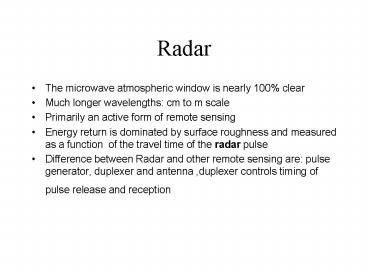Radar PowerPoint PPT Presentation
1 / 29
Title: Radar
1
Radar
- The microwave atmospheric window is nearly 100
clear - Much longer wavelengths cm to m scale
- Primarily an active form of remote sensing
- Energy return is dominated by surface roughness
and measured as a function of the travel time of
the radar pulse - Difference between Radar and other remote sensing
are pulse generator, duplexer and antenna
,duplexer controls timing of pulse release and
reception
2
Advantages
- All time / all weather capability
- Information on surface roughness at the human
scale - Centimeters rather than microns
- Penetration of soil function of the dielectric
constant - Rule of thumb is that for dry soils, penetration
depth (cm) 10 - For hyper-arid environments, radar can penetrate
3-5 meters
Disadvantages
- Very costly
- Imagery is complex and typically hard to
interpret - Little to no information on composition of the
surface materials
3
Radar Bands
- Radar pulses are sent and received in discrete
wavelength regions (designated with letters) - Controlled by the federal government so as not to
interfere with commercial broadcasting and
emergency frequencies - Most commonly used
- Ka-band 0.8 1.1 cm (1.0 cm)
- C-band 3.8 - 7.5 cm (5.3 cm) L-band 15.0 -
30.0 cm (23.5 cm) - X-band 2.4 3.8 cm (3.0 cm)
- S-band 12 cm
- P-band 30.0 - 100.0 cm (68 cm)
4
Two Radar Modes
- 1. Passive same principles as emitted energy in
the Thermal IR however, energy is a function of
the surface dielectric constant as well as the
temperature the dielectric constant is greater
for metals and soils with higher moisture content
- 2. Active most common form of radar remote
sensing. 90 of all data collected - known as SLAR (side-looking airborne radar) SLAR
can be either real aperture radar (RAR) or
synthetic aperture radar (SAR). Active remote
sensing controls the source as well as the data
collection - Energy is transmitted and received by an antenna
looking off at an angle to - the surface typically mounted to the side of a
planes fuselage for airborne systems - Side-looking geometry affects how the signal
interacts with the surface - also causes unique geometric distortions that
must be corrected - Nadir-viewing radar systems are known as radar
altimeters used for mapping topography
5
Terminology
- 1. Ground range distance away from the nadir
point (perpendicular to the flight direction) - 2. Slant range distance along the beam path
- 3. Azimuth distance along the flight direction
- 4. Look angle angle from the vertical to the
beam - 5. Depression angle complement to the look angle
- 6. Swath width illuminated surface on the
ground - 7. Pulse duration time of the pulse
6
Radar in Operation
- Beam pulse transmitted to surface illuminates a
narrow strip of land - Returned energy (backscatter) is received by the
antenna and the timing logged - Energy only returned if the surface is rough
compared to the wavelength - Corner reflector is an object on the surface
with a certain geometry with respect to the
incident energy whereby all the energy is
returned to the antenna - Near-range is received first (shorter travel
time) then the far-range - All backscatter within any given zone of the
swath width perpendicular to the azimuth
direction is received at the same time. there is
no way to resolve features within this strip
(azimuth resolution)
7
Radar Resolution
- The ability of the radar return to distinguish
between two objects in the range direction only
can happen if the received pulse from the object
closest to the antenna ends before the returned
pulse of the far-range object begins can be
defined in terms of the pulse duration and the
ground range distance - Shorter pulse duration and smaller depression
angles result in better range resolution - Common pulse duration 0.05 - 0.3 µseconds,
- Small depression angles produce large radar
shadows - Short pulse durations result in less return and
more noise
R ct/2 cos 0 Where C speed of light T
pulse duration 0depression angle
8
Azimuth Resolution
- Distance parallel to the azimuth (flight)
direction - Azimuth resolution equals the swath width
- Best resolution achieved with commercial systems
15-60m
Ra GR B Where GR ground range B antenna
beamwidth
9
Synthetic Aperture Radar (SAR)
- way around the RAR limitation by using the
motion of the plane (artificially enlarge the
antenna length) - Uses the principle of Doppler shift to track the
motion of objects in the azimuth direction
through successive pulses - Objects in the near range are observed for
shorter times than those in the far-range - Synthesized beam is much narrower than the
original swath width azimuth resolution can be
decreased to 5-20m
10
Radar Polarization
- SLAR systems can commonly transmit and receive in
different polarization planes (horizontal and
vertical) - results in image designations such as
- C-band horizontal send, vertical receive
- P-band horizontal send, horizontal receive
- Interaction with surface features can depolarize
the beam - The physical process of depolarization is not
always well understood - Horizontal send and receive is the strongest
most objects on the surface have a vertical
orientation therefore they scatter back most of
the energy - Depending on the surface properties of the
surface under study, vertical send/receive may
be important
11
(No Transcript)
12
(No Transcript)
13
(No Transcript)
14
(No Transcript)
15
(No Transcript)
16
(No Transcript)
17
(No Transcript)
18
(No Transcript)
19
(No Transcript)
20
(No Transcript)
21
(No Transcript)
22
(No Transcript)
23
(No Transcript)
24
(No Transcript)
25
(No Transcript)
26
(No Transcript)
27
(No Transcript)
28
(No Transcript)
29
(No Transcript)

